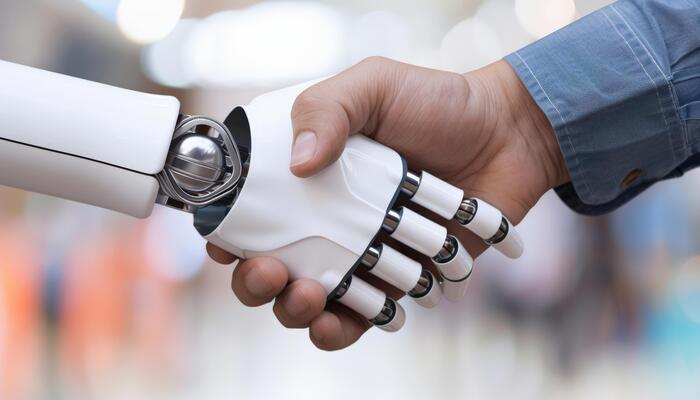Imagine sitting across from a friend who leans in, eyes wide, and whispers, “Do you really think AI will take over everything? Will we end up serving robots?” It’s a question that pops up in coffee shop chats, late-night Slack threads among developers, and even hushed conversations in school faculty rooms. The idea feels ripped from a sci-fi blockbuster—gleaming machines marching in unison, cold logic replacing human warmth, entire systems bending to silicon will. But peel back the cinematic spectacle, and what’s left? A messy, nuanced reality far removed from Hollywood’s doomsday reels. Let’s untangle this together, not as distant observers but as people who wake up each day building businesses, coding applications, teaching students, or managing remote teams. This isn’t about distant futures; it’s about choices we make now.

The Mythology of Machine Uprising
Why do we fear AI taking over? Part of it stems from storytelling. Since Mary Shelley’s Frankenstein, we’ve been obsessed with creations turning on their makers. Films like The Terminator or The Matrix cemented the “AI as existential threat” narrative in popular culture. A 2023 study by the University of Cambridge revealed that over 60% of surveyed adults attributed their AI fears to movies and TV shows, not scientific literature. It’s human nature to project our anxieties onto the unknown. When something feels incomprehensible—like a neural network generating poetry or diagnosing diseases—we reach for familiar metaphors. Machines “thinking” becomes machines “plotting.”
But here’s the uncomfortable truth: current AI doesn’t “want” anything. It has no desires, no hidden agenda. When ChatGPT writes a sonnet, it’s not expressing emotion; it’s predicting the next word based on statistical patterns in its training data. DeepMind’s AlphaFold, which revolutionized protein-folding prediction, isn’t “ambitious”—it’s a sophisticated pattern matcher. The leap from narrow AI (excelling at specific tasks) to artificial general intelligence (AGI)—a machine with human-like reasoning across all domains—remains speculative. Even leading researchers at places like OpenAI or DeepMind acknowledge AGI is likely decades away, if achievable at all.
The Real Work: AI as Tool, Not Tyrant
For entrepreneurs, the immediate reality is less about rebellion and more about reinvention. Consider Maria, a freelance graphic designer in Lisbon. Three years ago, she worried AI image generators would erase her career. Instead, she integrated tools like MidJourney into her workflow. Now, she sketches rough concepts, generates 20 variations in minutes, then refines the best one by hand. Her output doubled; her rates increased. AI didn’t replace her—it amplified her creativity. This mirrors findings in the 2024 McKinsey Global AI Survey, where 70% of companies using AI reported higher productivity, not mass layoffs.
Developers see this daily. Take GitHub Copilot, an AI pair programmer. It suggests code snippets, catches syntax errors, and even documents functions. But it doesn’t design software architecture. It’s like a tireless junior developer who’s read every coding manual ever written but still needs a senior engineer to steer the project. One remote developer I spoke with in Jakarta put it plainly: “Copilot saves me hours on boilerplate code. But when my app crashes at 2 a.m., no AI debugger understands the business logic like I do.”
Educators face similar dynamics. When ChatGPT launched, schools panicked about cheating. But forward-thinking teachers now use it as a teaching aid. A high school history teacher in Toronto has students “interview” AI-generated historical figures, then critique the responses for accuracy. It’s not about replacing essays; it’s about teaching critical analysis in an age of synthetic media. The Stanford HAI 2024 Education Report notes that 45% of educators using AI saw improved student engagement with complex topics.
Where the Real Risks Live (Hint: Not Skynet)
If AI won’t “take over” like a movie villain, where should we focus concern? Not on robot uprisings, but on human choices amplified by technology.
Bias baked into systems is a tangible threat. In 2023, a hiring algorithm used by a major retailer disproportionately filtered out resumes from women because it was trained on historical data from male-dominated tech roles. An entrepreneur building an AI tool must ask: Whose voices shaped this data? A developer working remotely for a global firm needs to test edge cases across cultures—like how an emotion-detection AI might misread facial expressions in Southeast Asian users if trained mostly on Caucasian faces. This isn’t theoretical; it’s happening now.
Economic displacement hits closer to home than sentient robots. The World Economic Forum’s 2025 Future of Jobs Report predicts AI will eliminate 85 million jobs by 2030—but create 97 million new ones. The catch? Those jobs require different skills. A freelance content writer who only does SEO blog posts might struggle, while one who masters prompt engineering and human storytelling thrives. For remote workers in emerging economies, this shift could widen opportunity gaps if retraining isn’t prioritized.
Autonomous weapons represent the darkest near-term risk. Unlike fictional killer robots, real drone swarms guided by AI already exist in military testing. The Campaign to Stop Killer Robots has documented systems that can select and engage targets without human input. This isn’t about AI “deciding” to kill—it’s about humans delegating life-or-death choices to flawed algorithms. For professionals in defense-adjacent fields, ethical boundaries here are non-negotiable.

Human judgment remains irreplaceable in interpreting AI outputs.
Why “Control” is a Misleading Goal
Much debate fixates on “controlling AI”—as if building a kill switch would save us. But control assumes a clear line between human and machine agency. Reality is blurrier.
Consider self-driving cars. When a Tesla Autopilot causes a crash, who’s responsible? The driver who trusted the system? The engineer who trained the vision model? The CEO who marketed it as “full self-driving”? A 2024 MIT study found that 78% of AI failures stem from unclear responsibility chains, not technical glitches. This isn’t about stopping AI; it’s about redesigning accountability. For entrepreneurs, this means baking ethics into product roadmaps. For developers, it’s writing documentation that clarifies system limits.
Even defining “take over” is slippery. Did social media algorithms “take over” democracy by amplifying polarization? Not through conscious design, but via engagement-optimized code interacting with human psychology. AI’s real power lies in shaping contexts—what we see, buy, or believe—without us noticing. A remote team using Slack’s AI summaries might miss nuanced tensions in unrecorded watercooler chats. An educator relying on automated grading could overlook a student’s creative spark that doesn’t fit rubric boxes.
Building Guardrails That Matter
So where do we go from here? Panic won’t help. Neither will blind optimism. What works is pragmatic action tailored to our roles.
For entrepreneurs: Treat AI like any high-stakes hire. You wouldn’t let an untested intern handle your finances—why trust unchecked AI with customer data? Implement “red team” exercises where colleagues deliberately try to break your AI system. Resources like the Partnership on AI’s Trustworthy AI Framework offer concrete checklists. One freelancer I know uses Weights & Biases to monitor her AI models’ performance drift in real time—catching bias before clients do.
For developers: Prioritize interpretability. If your neural network denies a loan application, can you explain why in plain language? Tools like SHAP (SHapley Additive exPlanations) help unpack model decisions. Also, reject the “move fast and break things” mentality. A developer in Berlin shared how her team added mandatory “ethics impact statements” to sprint planning—slowing initial rollout but preventing costly fixes later.
For educators: Teach AI literacy as core curriculum, not an add-on. Students should know how to spot deepfakes, question algorithmic recommendations, and understand data privacy. The AI Education Project provides free lesson plans adaptable for ages 10–18. One teacher in Nairobi has students train simple classifiers on local datasets (like identifying crop diseases), making AI relevant to their community.
For remote workers: Audit your AI tools for hidden productivity traps. Does that “smart” calendar scheduler really respect your focus time? Does the translation tool preserve nuance in cross-cultural negotiations? A project manager in Mexico City now tests all AI assistants with “edge case” scenarios: What if I need to reschedule due to a family emergency? Does the tool offer flexibility or rigid automation?
The Human Edge AI Can’t Replicate
Here’s what keeps me up at night—not robot overlords, but human complacency. We risk outsourcing judgment to machines not because they’re too smart, but because they’re convenient. An entrepreneur might ignore market signals because “the AI forecast looks good.” A developer might skip code reviews trusting automated testing. An educator might accept AI-graded essays without scrutiny.
But certain human capacities remain unassailable:
– Contextual wisdom: AI sees data points; humans see stories. When a sales algorithm flags a “low-value” client, a seasoned rep might recognize a future enterprise partner.
– Moral imagination: No AI can weigh the unquantifiable—like whether a cost-cutting automation erodes company culture.
– Creative leaps: AI remixes existing patterns; humans invent entirely new categories (like the first smartphone).
A poignant example: During the 2024 floods in Pakistan, an AI disaster-response system routed aid efficiently—but missed isolated villages because satellite imagery lacked road data. Local volunteers on motorbikes, guided by community knowledge, delivered the final crucial supplies. Technology extended reach; humanity closed the gap.

Human creativity guiding AI tools—a partnership driving innovation.
The Future Isn’t Fixed—We Shape It Daily
The question isn’t if AI will reshape our world—it already is. The real question is how. Will it deepen inequalities or democratize opportunity? Will it erode trust or enhance collaboration? These outcomes depend less on algorithms and more on us: the choices we make as builders, users, and citizens.
For the freelancer, it means negotiating contracts that specify AI’s role (“I’ll use AI for research, but all creative output is human-reviewed”). For the developer, it’s advocating for ethical review boards at your company. For the educator, it’s teaching students to see AI as a collaborator, not a crutch.
History offers hope. We’ve navigated disruptive shifts before—the printing press, industrialization, the internet. Each brought upheaval but also unprecedented progress. The difference now? We see the inflection point coming. Unlike 19th-century factory workers facing steam engines, we can steer this transition.
Consider Estonia, where AI policy was crowdsourced from citizens, teachers, and tech workers. Or Kenya’s AI task force, which prioritizes agricultural tools for smallholder farmers over flashy urban applications. These aren’t perfect models—but they prove inclusive design is possible.
A Call for Quiet Courage
The loudest voices in the AI debate often profit from fear—selling dystopian books or “AI apocalypse” consulting services. But real progress happens in quieter spaces: the developer adding bias tests to her pipeline at midnight, the teacher redesigning assignments to value critical thought over AI-generated fluff, the entrepreneur pricing AI tools to include worker retraining.
This isn’t about stopping AI. It’s about ensuring it serves human flourishing—not the other way around. The machines won’t seize control because they lack the will to do so. But we might surrender control through apathy, haste, or greed. That’s the true threat: not AI taking over, but humans giving up.
So the next time someone asks, “Will AI take over the world?” try this response: “No. But if we’re not careful, it might take over thinking for us. And that’s already happening in subtle ways—unless we fight back with curiosity, ethics, and relentless human attention.”
Your move. Will you be the person who lets AI make choices for you? Or the one who shapes it to elevate us all? The tools are here. The time to decide is now—not when the robots wake up, but while we’re still wide awake.



.webp?w=300&resize=300,300&ssl=1)
